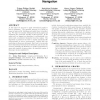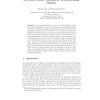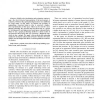10 search results - page 1 / 2 » Applying hierarchical graphs to pedestrian indoor navigation |
GIS
2008
ACM
14 years 5 months ago
2008
ACM
In this paper we propose to apply hierarchical graphs to indoor navigation. The intended purpose is to guide humans in large public buildings and assist them in wayfinding. We sta...
KI
2008
Springer
13 years 4 months ago
2008
Springer
The complexity of pedestrian spatio-temporal behaviour calls for the combination of several complementary empirical methods in order to comprehensively understand human motion beha...
DASFAA
2011
IEEE
12 years 8 months ago
2011
IEEE
Route planning, which is used to calculate feasible routes in a given environment, is one of the key issues in navigation systems. According to different constraints in different...
ICRA
2006
IEEE
13 years 11 months ago
2006
IEEE
— Mobile robot localization and navigation requires a map - the robot’s internal representation of the environment. A common problem is that path planning becomes very ineffic...
CVPR
2007
IEEE
14 years 6 months ago
2007
IEEE
In this paper, we present a compositional boosting algorithm for detecting and recognizing 17 common image structures in low-middle level vision tasks. These structures, called &q...



